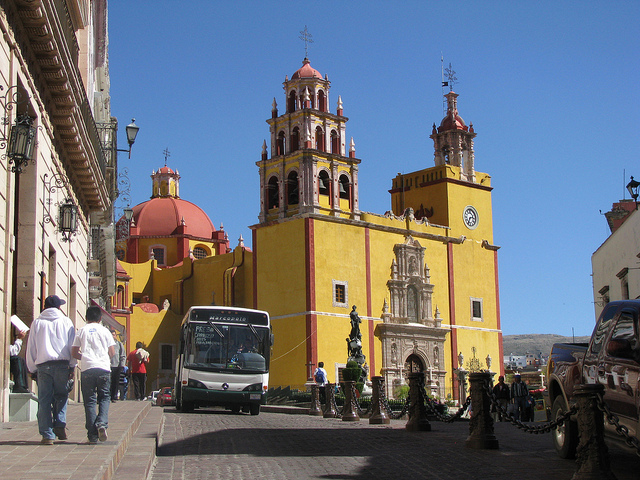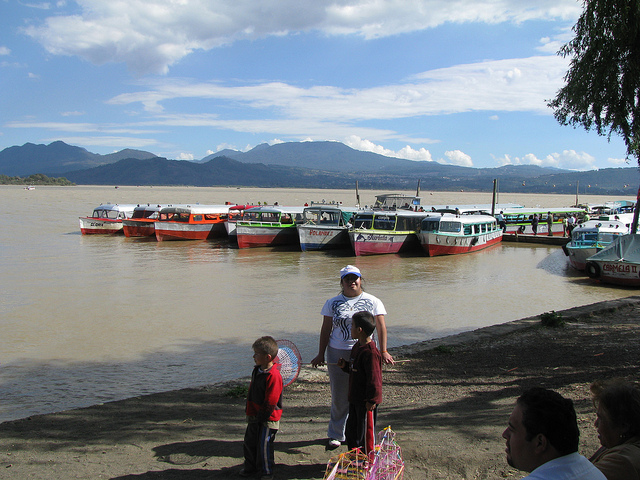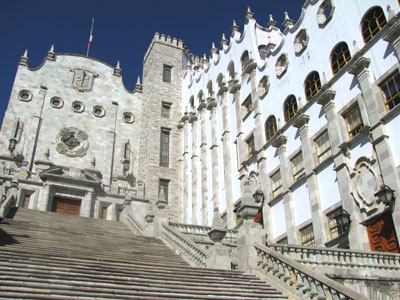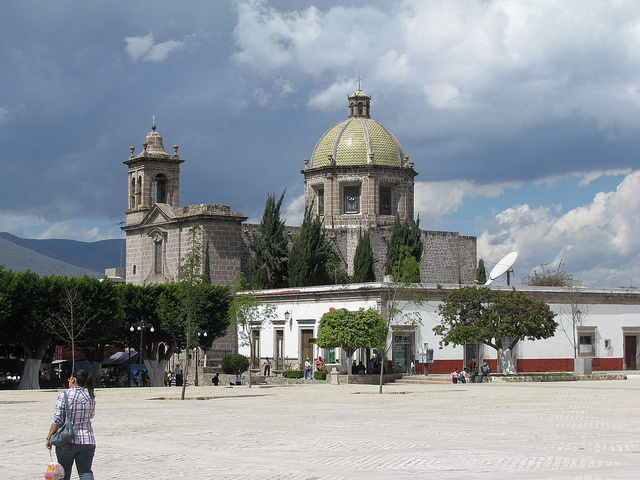Sujei took me down into the mine on the steep steps which were occasionally interspersed with recesses that featured crosses and religious shrines, reminding us of the precarious and heavy work involved in mining. This mine shaft is not very deep or long but it gives you an idea of the cramped and dangerous working conditions that miners have been facing since time immemorial. Although the La Valenciana mine is less productive today, silver is still being extracted here.
Back upstairs in the glorious sunshine we moved on to our next destination: the baroque Church of La Valenciana, built between 1740 and 1788. The church sits on a hill and wonderful views can be had from its courtyard over the surrounding mountains and the city of Guanajuato which is embedded underneath. The façade of the church impresses with its intricately carved red sandstone exterior in a style that is called churrigeresque baroque. The extensive ornamentation continues inside where the main altar and two side altars are covered in gold leaf. Huge old art works hang on the church’s walls, depicting scenes from the Bible. The Church of La Valenciana overwhelms the visitor with its opulent artwork and ornamentation.

The Church of La Valenciana
As we continued our drive down back into the city, I asked Sujei where we were heading next. She explained we were going to visit one of Guanajuato’s most well-known sights: El Pípila, a monumental statue with a height of 28 metres that overlooks downtown Guanajuato from the top of San Miguel Hill.
Our drive to this monument took us through the famous underground tunnel network of Guanajuato which were originally underground channels for the Guanajuato River. An often confusing network of underground roads paved with cobblestones weaves its way under the city, and many of the tunnels are flanked by sidewalks. There are even underground bus stops and parking spots beside the underground streets of Guanajuato. I was fascinated by this subterranean parallel world underneath the city and particularly by the fact that it seemed very safe. I saw many families and single women walking through the tunnel system; it just seemed like this underground road network was just like any other part of the city, full of life and activity.

Guanajuato’s road tunnels are fascinating
As we started driving up the mountain, Sujei also told me that Guanajuato is an important university town. As a result, the demographic makeup of the city is quite young which manifests itself in the excellent entertainment opportunities in the city. Guanajuato’s thriving entertainment scene features many popular clubs and restaurants.
After a brief drive through the downtown area of Guanajuato we were climbing again and finally reached our next stop: the El Pípila Monument on San Miguel Hill. El Pípila was actually Juan José de los Reyes Martinez, a miner who played an important role at the beginning of the Mexican War of Independence in 1810. The insurrection against the Spaniards had begun in the nearby town of Dolores, led by Miguel Hidalgo, an important leader of the Mexican War of Independence. As the insurrection spread to Guanajuato, the Spaniards barricaded themselves inside La Alhóndiga, the city’s fortress-like granary.

“El Pípila” – Guanajuato’s independence hero
Carrying a long flat stone on his back to protect himself from the muskets of the Spanish soldiers, El Pípila torched the door of the granary and set it on fire. As a result the insurgents stormed inside and killed all the Spanish soldiers, an important point in the Mexican fight for independence against the Spanish. So today, El Pípila is celebrated as Guanajuato’s local hero. Constructed in 1939, the monument itself is built of pink sandstone and depicts a muscular man with a flaming torch. Surrounding the monument is a series of stone terraces that offer the most magnificent view over the city of Guanajuato.
I was enchanted by the tapestry of colourful houses that are patched up against the surrounding mountainsides. Sujei explained the most important landmarks to me that were stretching out below: the town’s main square, a green treed triangle, is Jardín Union which is joined by the Teatro Juarez, a renowned performing arts venue built in a mixture of Roman, Greek and Moorish styles. This theatre was inaugurated in 1903 by then Mexican president Porfirio Diaz. Next to it is the building that houses the funicular that takes visitors comfortably up to San Miguel Hill for a visit to El Pípila.

The Cathedral and the University of Guanajuato, viewed from “El Pípila”
A little to the left I saw the yellow and orange cathedral, the impressive Basilica of Our Lady of Guanajuato which was built between 1671 and 1696. Just above the Cathedral on the hill is the University of Guanajuato, an imposing white sandstone building with crenellated towers. Further west is the grey square of La Alhóndiga, and not far away is the domed roof of the Mercado Hidalgo, the municipal market.
Surrounding the monument are a series of outdoor stalls that sell fruits, candy, souvenirs and typical Mexican handicrafts made from wood, metal and leather. Sujei showed me some of the local munchies which included home-made crispy fried potato slices, various wheat-based snacks and “chicharron”, deep-fried pork skin. Miniature violins and the decorative colourful “catrina” skeletons round out the assortment of Mexican merchandise.
Now it was time for a late lunch, so Roberto, our trusted driver, took us back into the city to the Jardín Union, the city’s main square. I was looking forward to getting an up-close look at the heart of Guanajuato.




